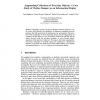Free Online Productivity Tools
i2Speak
i2Symbol
i2OCR
iTex2Img
iWeb2Print
iWeb2Shot
i2Type
iPdf2Split
iPdf2Merge
i2Bopomofo
i2Arabic
i2Style
i2Image
i2PDF
iLatex2Rtf
Sci2ools
PERVASIVE
2004
Springer
2004
Springer
Augmenting Collections of Everyday Objects: A Case Study of Clothes Hangers As an Information Display
Though the common conception of human-computer interfaces is one of screens and keyboards, the emergence of ubiquitous computing envisions interfaces that will spread from the desktop into our environments. This gives rise to the development of novel interaction devices and the augmentation of common everyday objects to serve as interfaces between the physical and the virtual. Previous work has provided exemplars of such everyday objects augmented with interactive behaviour. We propose that richer opportunities arise when collections of everyday objects are considered as substrate for interfaces. In an initial case study we have taken clothes hangers as an example and augmented them to collectively function as an information display.
Applied Computing | Common Everyday Objects | Everyday Objects | Human-computer Interfaces | PERVASIVE 2004 |
| Added | 02 Jul 2010 |
| Updated | 02 Jul 2010 |
| Type | Conference |
| Year | 2004 |
| Where | PERVASIVE |
| Authors | Tara Matthews, Hans-Werner Gellersen, Kristof Van Laerhoven, Anind K. Dey |
Comments (0)

